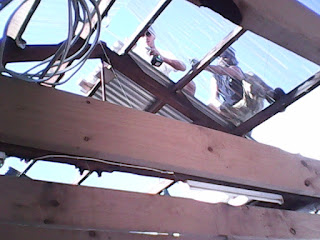Gender
segregation is so totally misunderstood.
From my experience, and I have had two that are from very different
cultures, it is not women being kept in by men, but women keeping men out.
As a
Traditional Jew, I recall walking round to the Shul where my Paternal Grand-Father
had davened before joining a break-away Minyan a year or so before he died of
pneumonia, a couple of years before I was born.
My Grand-Mother had returned, but my Father had stopped doing everything
and had fallen out with his Father because of it. My Parents had been married at an old,
assimilated congregation on the other side of the highway, where my Paternal Grand-Parents
were apparently not made welcome and never visited again, or so I vaguely
recall being told once by some unknown congregant who spoke to me once.
Most of my
childhood is a forgotten haze, mostly spent sick in bed, where my cousins all
thought I was a lazy malingerer and never ever visited me, even once. I do recall a single Yom Kippur when my
Father and I walked together to see my Grand-Mother. I remember him being shooed out of the women’s section, where everyone was
sitting or standing in pious silence, most with a book in hand. My Grand-Mother sent my Father away immediately,
but called me over and we greeted. I
think it was one of the last times I saw her before the last when she was in
hospital and gave me a carnation flower to remember her by. I still have it, put away, somewhere. I wanted to stay with her, but she told me I
couldn’t stay because
boys were not permitted, and sent me out to find my Father, who was glad to see
me because he wanted to go immediately.
I caught only a glance of the Men before being whisked away, thinking
that there may have been chamber pots in the women’s gallery or perhaps that was just
what a lot of women smelt like. While
there was a women’s gallery in the
Synagogue that I attended every Shabbos and Yom Tov, it had was open to view
from the men on the opposite side, with a divided community of men on one side
downstairs and women on the other upstairs.
There was a women’s section at
the back, but that was not curtained off at all. There used to be someone in the front row
there, almost hidden from view by the raised, central reading desk, whom I was
told a step-relation had married, but who no longer spoke to us.
Many
decades later, by chance I came to be renting a small stone house in a little town
in the central Himalayas, in what is now Utterakhand but had been a separate Kingdom
of Kumaon before the British annexed it and it became part of Utter Pradesh. I had initially been attracted by the tenth century
and older Siva Mandirs, a period of Architectural History I had studied at
university. It was very traditional and
at first I only met the men who sat round in tea-houses waiting for pilgrims
who would pay them a pittance for performing ancient rituals on their
behalf. It was particularly famous since
ancient times for helping barren wives.
To my astonishment, the fecundity of the local Priesthood was never
credited, even during the annual festival when girls stood all night in the
Temple Forecourt holding a lit oil-lamp, while their mothers waited at the
side, only leaving their post for an occasional call of nature; I was warned to
stay indoors, shutter the windows and lock the door and not to even light a
fire to cook or a single wick in my oil lamp by which to read, but I had
already heard some of them boasting in the tea-shops of the miraculous success
of yet another married lady, recently conceived after a long and fruitless
marriage, and drew conclusions. It may be
salient that Kumaoni men were renowned in the British Army for their valour in
combat, but they were a different cast from the Brahmins who made me welcome. After some months renting a town house I
started to be invited to family farms that surrounded the town. They were generally large, multi-story
buildings, often of ancient construction, housing extensive, extended families
of many generations. My friends tended
to be young and apparently un-married, and many who claimed to be brothers were
really cousin-brothers with sibling fathers who had all been raised communally
within the family. The Women ruled the
home and its surrounding farm, where they were all the personification of the
Goddess Sita, born in the furrow of a plough, consort of Rama, or Parvati, one
of the consorts of Siva, whose mountains (euphemism intended) were the most
beautiful. I was made very welcome at
some hearths, while in other homes I quickly learnt to keep a respectful distance,
sometimes eating round a corner or through a doorway, sometimes out of eye-shot
but always within ear-shot. Is any of
this interesting? Suddenly memories are flowing back like the Ganga streams
that flowed down the steep hillsides from natural springs near the peaks. Those women had the freedom to go to town and
sometimes did, especially during the Mela, the great annual spring fair when
overnight a whole street-length of stalls popped up to line the usually bare
road into town and my friends had their busiest day of the year making clay
Shiv Linga for families who had their own traditional Priest that they would
only see this once a year, often expecting to be accommodated free including
food as well as Mantras, when all the women dressed in their most beautiful
saris with all their gold anklets, bracelets and ear and nose rings, but they
chose not to. The men had no such
freedom at home and I when men were not needed in the fields under the women’s supervision they would be sent to
town to earn a few rupees by priestly duties.
What
happens in traditional Moslem societies I do not know, but having experienced
traditional Hindu and Jewish societies, I suspect it is much the same. It had probably been like that since time
immemorial right up to The Prophet of Islam (peace be unto him) who wrote for
people who lived in a world where men were excluded from Women’s collective space, usually round
the hearth and the well.
Jageshwar
had no well but a natural stone bath, that had probably been hollowed out by millennia of bathers. It was just near
the edge of the wide, stone ledge at the bend in the river opposite where
funerals are held, though the small stream that cascaded down the mountain at
that place may have gouged out its own little stone basin. This was the Brahma Kund, the Bath of
re-birth, where everyone entering the temple was expected to immerse themselves
prior to entry. If you climbed the track
up the mountain, the stream gurgled down near the path, and the slower zig-zag
path that criss-crossed the direct, steep descent sometimes also crossed the
creek. Not far below the top of the
path, where clear sky could be seen up ahead between the remaining trees up to
the ridge that curved up and away on either side, and beyond which was an even
steeper descent that received little sunlight and was the home to wandering
mystics, human sized red monkeys, wild bears and the famous tigers of Kumaun,
there is a little temple amongst the trees, like a lot of the temples that dot
these hills it is about the size of a child’s cubby house, though in the
traditional stone design, and is just big enough for a Rishi to sit inside in
meditation sometimes for months or supposedly years without moving, some with a
permanent Phallic erection, though now days the temples are either empty or
have a Shiv Lingum, the votive image of this branch of Hinduism that represents
the Penis within the vagina, as the Lingum always protrudes out of the Yoni. Anyhow, this particular temple has neither
inside and cannot be entered, because it has no floor on which to sit in
meditation, but instead is full of water that gushes out over the thresh-hold
and flows down the mountain. I bathed
regularly in that water, which may have been slightly radio-active or
something, because I staggered into Jageshwar, a life-long invalid and am
remembering this now, four decades later or more: It was a magick place with
healing water. When I went down to bath
each morning I also took my bucket, because to make a cup of tea in my house I
had to go up to the forest with an axe for the wood and down to the river with
the bucket for the water. Sometimes
when I bathed, the second time I went there to live, Parvati Bhatt came to fill
her bucket. We could not speak as she
only knew the local dialect of Kumauni and even less Hindi than myself, but I
did discuss marriage with her Father, and might have been living now in
Paradise married to a Goddess now, had my own Father not turned up and
collected me and brought me back, but that is a story for another day.
The Western
Christian perception of those traditional societies has been wrong since first
contact. We understand that in Europe
things evolved differently during the last, long Ice Age, that we call the New
Stone Age, the Neolithic. Instead of
extended families, primogeniture meant that instead of brothers living
together, a single son took everything, while the rest went into the army or
the church. These households had few
women and they were vulnerable, so they were kept protected, particularly from
the soldiers that would frequently marauder through the local countryside on
their way to do battle against enemies they did not know for their landlords
whom they respected but also did not know, who would often rape and pillage in
the process of extracting taxation and supplies for their armies. This is the social pattern that Europeans see
when they look at other cultures, so that when they see a society that divides
along gender lines and tends to keep the sexes separate, they assume that the
women are being kept in, but in reality the men are being kept out.
Naum Tered
18-4-17











